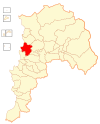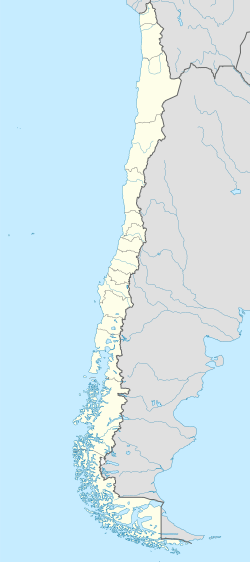Puchuncaví facts for kids
Quick facts for kids
Puchuncaví
|
||||
|---|---|---|---|---|
|
Town and Commune
|
||||
|
||||
| Country | Chile | |||
| Region | Valparaíso | |||
| Province | Valparaíso | |||
| Government | ||||
| • Type | Municipality | |||
| Area | ||||
| • Total | 299.9 km2 (115.8 sq mi) | |||
| Elevation | 32 m (105 ft) | |||
| Population
(2012 Census)
|
||||
| • Total | 15,179 | |||
| • Density | 50.614/km2 (131.088/sq mi) | |||
| • Urban | 11,099 | |||
| • Rural | 1,855 | |||
| Sex | ||||
| • Men | 6,643 | |||
| • Women | 6,311 | |||
| Time zone | UTC-4 (CLT) | |||
| • Summer (DST) | UTC-3 (CLST) | |||
| Website | Municipality of Puchuncaví | |||
Puchuncaví is a town and a special kind of local government area called a commune in central Chile. It's located in the Valparaíso Province, which is part of the Valparaíso Region. This coastal area covers about 299.9 square kilometers.
History of Puchuncaví
The story of Puchuncaví and its nearby areas goes back more than 500 years. It is one of the oldest places in Chile. The name "Puchuncaví" comes from the Mapudungun language. It means "where fiestas (parties) are plentiful." Some people also think it means "Remains of Fiestas" or "End of Fiestas."
We don't know the exact date when Puchuncaví started. People believe that when the Spanish arrived, there was already a small village here with this name. Puchuncaví was one of the stops on the famous Inca road system. This was a stone path that connected central Chile with Cuzco, Peru, which was the capital of the Inca Empire.
A Curaca, who was a direct representative of the Inca ruler, lived in Puchuncaví. Their job was to collect taxes and crops. They also made sure the Inca's rules were followed by the local people. When the Spanish arrived, the leader Pedro de Valdivia gave the Puchuncaví valley to one of his soldiers, Milán Vicenzo del Monte. He was from Italy and was a nephew of Pope Julius II.
Later, his family divided the land among themselves. By the 1600s, many different people owned parts of the land. On December 8, 1691, the church area (Parrish) of Puchuncaví was created. This was done by Juan Manuel Benavides y Mujica, who was a chaplain during Chile's fight for independence.
On March 6, 1875, Puchuncaví was officially declared a "Villa" (a small town). It was even a provincial capital several times. In 1894, the first commune called "Quintero-Puchuncaví" was formed. It brought together Puchuncaví and the nearby town of Quintero.
In 1929, President Carlos Ibáñez del Campo decided to combine smaller communes. Because of this, Puchuncaví was removed as a separate commune and became part of Quintero. This made things difficult for Puchuncaví. After a long time of being dependent on Quintero, Puchuncaví finally became its own commune again. This happened on October 15, 1923, through Decree No. 3827. Many local leaders and residents worked hard to make this happen.
Then, in 1943, the leaders of the Quintero commune decided to separate the two cities. After many meetings with people from the area and local authorities, they achieved this separation. On September 13, 1944, Law Decree No. 7866 was issued by President Juan Antonio Ríos. This created the Municipality of Puchuncaví. It included eight districts: Placilla de Puchuncaví, La Laguna, La Canela, San Antonio, Pucalán, Melosillas, Los Maitenes, Campiche, La Greda, Las Ventanas, La Chocota, and Horcón.
In 1975, the Quillota Province was created, and the Valparaíso Province was reorganized. At this time, Puchuncaví became part of the Valparaíso Province.
People and Places in Puchuncaví
According to a census in 2002, Puchuncaví had 12,954 people living there. Most of them, about 11,099 people (85.7%), lived in urban areas (cities and towns). The rest, 1,855 people (14.3%), lived in rural areas (the countryside). At that time, there were 6,643 men and 6,311 women. The population grew by 21.5% between 1992 and 2002.
The commune of Puchuncaví includes several towns and smaller areas. Here are some of them:
- Las Ventanas: This town has a large factory called the Foundry and Refinery of Las Ventanas, which opened in 1964.
- La Chocota and Horcón: These places are known for their handcrafted boats.
- Maitencillo: Here you can find the Marbella Resort.
- El Rungue: This countryside area is famous for its traditional restaurant called El Caballito de palo (which means "Stick Pony").
- Pucalán and Los Maquis: The people here mainly work in making coal and farming.
- Campiche: People in this area mostly grow tomatoes and other vegetables.
- Other areas include La Canela, La Quebrada, El Paso, La Laguna, Chilicauquen, El Rincón, and El Leon.
How Puchuncaví is Governed
As a commune, Puchuncaví is a local administrative division of Chile. It is managed by a communal council. The head of the council is an alcalde (mayor), who is chosen directly by the people every four years. The alcalde from 2008 to 2012 was Agustín Valencia García.
The communal council members during that time were:
- Ana Rosa Villarroel Pacheco (UDI)
- Fernando Vicencio Bazáes (PRSD)
- Guillermo Herrera Figueroa (PDC)
- Mauricio Cancino Quezada (RN)
- Ramón Barría Pino
- Eugenio Silva Pinto (Ind. / RN)
Puchuncaví is part of a larger electoral district. This means that when people vote for members of the Chamber of Deputies (like a parliament), Puchuncaví votes with several other communes. These include La Ligua, Petorca, Cabildo, Papudo, Zapallar, Quintero, Nogales, Calera, La Cruz, Quillota, and Hijuelas. The representatives for this district were Eduardo Cerda (PDC) and Andrea Molina (UDI).
For the Senate, Puchuncaví is part of the 5th senatorial area (Valparaíso-Cordillera). The senators for this area were Ignacio Walker Prieto (PDC) and Lily Pérez San Martín (RN).
See also
 In Spanish: Puchuncaví para niños
In Spanish: Puchuncaví para niños



